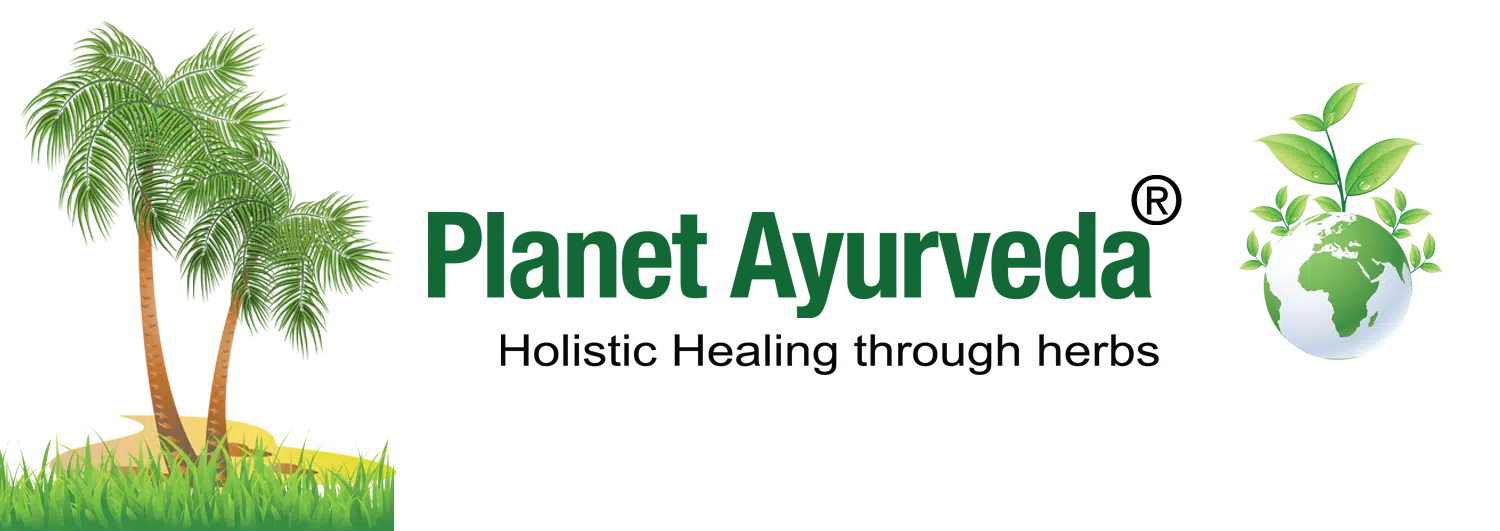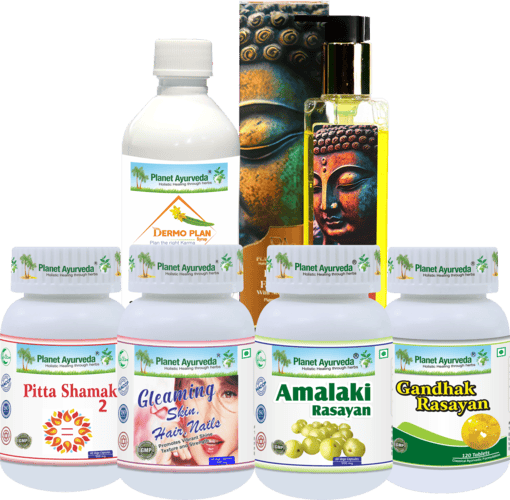Acne Rosacea – Causes, Symptoms, Treatment & Herbal Remedies
Abstract
Skin disorders, known as Kushtha Roga (Skin disorders) in Ayurveda, encompass a wide range of conditions affecting the skin, the body’s largest organ. The skin serves as a protective barrier, regulates temperature, excretes toxins, and reflects internal health. Acne Rosacea is a long-term skin condition that mainly affects the central parts of the face, like the cheeks, nose, forehead, and chin. In Ayurveda, it is correlated with Pitta-Rakta dominant Kushtha Vyadhi (Skin disorder). Acne Rosacea, due to its visible redness, flushing, and facial eruptions, can have a significant psychosocial impact. Many individuals experience self-consciousness, embarrassment, and reduced confidence because the condition affects highly visible areas like the face.

Introduction
Acne Rosacea is a non-contagious, autoimmune, long-term inflammatory skin condition predominantly affecting the central areas of the face, such as the cheeks, nose, forehead, and chin. Synonyms for Acne rosacea include- Rosacea, Couperose, and Facial erythrosis. In German, it is referred to as ‘Kupferfinne’ and ‘Rotfinne’. It is most frequently observed in fair-skinned adults aged 30 to 50 and often follows a pattern of flare-ups and remission. The condition is marked by persistent facial redness (erythema), visible small blood vessels (telangiectasia), papules, pustules, and occasionally eye involvement. Although it may resemble acne due to the presence of pustules, it is a separate disorder with significant vascular changes and heightened skin sensitivity. Unlike acne vulgaris, comedones (blackheads or whiteheads) are absent, and the disorder is linked to chronic inflammation and dysregulation of facial blood vessels.
Types
1. Erythematotelangiectatic Rosacea
Red areas of skin on the face, sometimes small blood vessels are visible.
2. Papulopustular Rosacea
As well as facial redness, there are red bumps (papules) and pus-filled spots (pustules).
3. Phymatous Rosacea
The skin thickens and may become bumpy, particularly on the nose (rhinophyma).
4. Ocular Rosacea
This type of rosacea involves the eyes. It causes dryness, irritation, redness, burning, or watery eyes.
Causes
- Genetics- Family history increases risk.
- Immune Dysregulation- Overactive immune response triggers inflammation.
- Vascular Issues- Dysfunctional facial blood vessels cause redness and flushing.
- Demodex Mites- High numbers of Demodex folliculorum can worsen inflammation.
- Environmental Triggers- Sun, heat, cold, wind, and humidity aggravate symptoms.
- Lifestyle/Diet- Alcohol, spicy foods, hot drinks, and stress can trigger flare-ups.
- Microbial Factors- Certain skin bacteria like Bacillus oleronius may intensify inflammation.
- Hormonal & Neurological Factors- Hormone changes and nerve sensitivity contribute to flushing and burning.
Symptoms
- Flushing of face- More prominent in lighter skin tone.
- Warmth- Excessive heat felt on the affected area.
- Persistent Redness- Red, violet, or brown discoloration.
- Acne-like Breakouts- Papules and pustules appear. They may be the first sign in darker skin.
- Visible Blood Vessels- Seen mainly in lighter skin on cheeks or nose.
- Dry, gritty, burning, or itchy eyes.
- Increased light sensitivity in eyes.
- Thickened Skin (Rhinophyma)- Usually seen in chronic cases.
- Burning/Stinging & Dryness- Skin may burn, sting, feel tight, dry, or rough.
- Itching- Rare, usually due to dryness or irritation.
Diagnosis
1. Patient History
Evaluating symptom patterns, triggers, family history, and how long symptoms have been present.
2. Physical Examination
Checking for persistent facial redness, visible blood vessels, papules, pustules, skin thickening, and eye involvement.
3. Excluding Other Conditions
Differentiating from acne, lupus, seborrheic dermatitis, or allergic reactions that resemble rosacea.
4. Eye Evaluation
Referring to an ophthalmologist if there are signs of ocular rosacea.
Treatment
Topical Gels/Creams
- Brimonidine and oxymetazoline reduce flushing temporarily.
- Azelaic acid, metronidazole, and ivermectin help control pimples.
Oral Acne Medicine
Isotretinoin is used for severe, resistant cases but is unsafe in pregnancy.
Oral Antibiotics
Doxycycline treats moderate to severe bumps and pimples.
Laser Therapy
To reduce the appearance of enlarged blood vessels and persistent facial redness.
Ayurvedic Overview
Ayurveda sees Acne Rosacea as Kushtha Roga (Skin disorder), but there is no direct correlation to any particular Kushtha Roga. Based on its symptoms and presentations, we can say that it is a Pitta-Rakta Pradhan Kushtha Roga. When a person, particularly of Pittaj Prakriti is over indulging in Pitta increasing diet and lifestyle, it manifests. Foods that aggravate Pitta include those that are hot, pungent, and sharp (Ushna, Tikshna, Katu), sour and fermented (Amla, Amla Rasa), salty (Lavana Rasa), heavy, oily, and rich in protein (Guru, Snigdha Ahara), as well as alcoholic beverages (Madya). Along with this, Atiatapsevan (Being in the sun too much), sitting near fire, Vegavidharana (Suppression of natural urges like urination) also causes Pitta aggravation. This aggravated Pitta vitiates Rakta dhatu (Blood Tissue) as well, since they are known to have similar properties.
तैर्हेतुभिः समुत्क्लिष्टं पित्तं रक्तं प्रपद्यते|
तद्योनित्वात् प्रपन्नं च वर्धतेतत् प्रदूषयत्||
तस्योष्मणा द्रवो धातुर्धातोर्धातोः प्रसिच्यते|
स्विद्यतस्तेन संवृद्धिं भूयस्तदधिगच्छति||
This means, when Pitta is aggravated, it leads to the vitiation of Rakta (blood). Owing to the similarity in their constitution, the imbalance of Pitta further intensifies the vitiation of Rakta. The heat of Pitta draws out the fluid component from all affected Dhatus, which in turn contributes to the simultaneous aggravation of both Rakta and Pitta.
This Pitta-Rakta Pradhan Kushtha Roga, shows symptoms like Raga (redness of the skin), Paka (representing inflammation or pustular eruptions), Kandu (intense itching), Rukshata (dryness and roughness of the skin) and Daha (burning sensation). Additionally, Pidaka (vesicles or blisters) may form on the affected areas. In Ayurveda, treatment of Acne Rosacea includes use of herbs, some herbal formulations for external application and also some purifying therapies. Herbs like Chandana (Santalum album), Tunga (Calophyllum inophyllum), Padmaka (Prunus cerasoides), Ushira (Vetiveria zizanioides), Madhuka (Glycyrrhiza glabra), Manjistha (Rubia cordifolia) and Sariva (Hemidesmus indicus) are very beneficial in this. Local application of Chandraprabha Lepa and Churna made from Varnya mahakashaya (10 herbs that enhance skin) also helps in relieving symptoms and nourishing skin. Use of Mahatikta Ghrita, Khadiradi Ghrita is useful as well. Classical formulations like Gandhak Rasayan, Amritadi Guggul, Arogyavardhini Vati, Khadirarishta, Sarivadiasava etc are most beneficial in Kushtha Roga (Skin disorders).
Acharya Charaka has explained the use of Panchakarma therapies in Kushtha Rogas (Skin diseases) in the shloka below-
वातोत्तरेषु सर्पिर्वमनं श्लेष्मोत्तरेषु कुष्ठेषु|
पित्तोत्तरेषु मोक्षो रक्तस्य विरेचनं चाग्रे||
This means in Vataja Kushtha, treatment should begin with Ghritapana (internal administration of medicated ghee). For Kaphaja Kushtha, Vamana (therapeutic emesis) is recommended as the initial therapy. In Pittaja Kushtha, the first line of management involves Virechana (purgation) along with Raktamokshana (therapeutic bloodletting).
Virechan therapy (Therapeutic purgation therapy) is useful in Acne Rosacea since it is a Pitta-Rakta predominant skin disease. Some studies have shown that Jalauka Avcharan (Leech therapy) also has excellent results since there is removal of vitiated Rakta (blood tissue) through this.
Dietary Habits And Lifestyle Modifications
Dietary Habits
Include raw foods, especially fresh fruits and vegetables, sprouted seeds, raw nuts and whole grain cereals, particularly millets and brown rice in your diet. Fruits like apples, pears, grapes, pineapples and peaches are recommended. Whereas, citrus fruits, bananas, dried, stewed or tinned fruits are to be avoided. Also avoid spicy foods, alcohol, caffeine, white flour and all its products. Vitamin A and Niacin rich foods like carrots, sweet potatoes, pumpkin, dark leafy greens (spinach, kale, fenugreek leaves), red and yellow peppers, mangoes, papaya, apricots, legumes (lentils, chickpeas, beans), seeds (sunflower seeds, pumpkin seeds, flaxseeds), mushrooms and potatoes should be consumed for preventing acne.
Lifestyle Modifications
Avoid exposure to sunlight, stress, very hot or very cold showers, chilly winds. Avoid rubbing or scratching your face, as it may aggravate the condition. Add Yogasanas like Bhujangasana (Cobra pose), Sarvangasana (Shoulder stand), Matsyasana (Fish pose) and Halasana (Plow pose) to your routine. Practice Pranayama (Breathing techniques) like Anulom-Vilom (Alternate nasal breathing), Sheetali (Cooling breath) and Bhramari (Bee breath).
Herbal Remedies For Acne Rosacea By Planet Ayurveda
Planet Ayurveda is a trusted name in holistic wellness, dedicated to reviving the ancient science of Ayurveda in its purest form. The brand offers a wide range of herbal supplements, classical formulations, powders, oils, and wellness packs, all prepared from authentic herbs. Every product is crafted from time-tested formulations found in classical Ayurvedic texts and manufactured under strict quality standards, ensuring both safety and efficacy.
For Acne Rosacea, We Have The Following Medicines
- Gandhak Rasayan
- Pitta Shamak-2
- Gleaming Skin, Hair, Nails Formula
- Dermo Plan Syrup
- Degrease Face Wash
- Amalaki Rasayan
Product Description
1. Gandhak Rasayan
These tablets are made from Shuddha Gandhak (Purified Sulphur). It pacifies Vata and Kapha doshas primarily. It is Raktashodhak (Blood purification), Shothahara (Anti-inflammatory), Krimighana (Antimicrobial) and Ropana (wound healing) in action. It provides relief from redness, pustules, burning sensation and also prevents recurrence by strengthening Tvacha (Skin tissue).
Dosage – 2 tablets twice daily.
2. Pitta Shamak-2
These capsules are made from potent herbs like Pitta Papda (Fumaria indica) and Patol (Trichosanthes dioica). It balances Pitta and Kapha doshas and has active constituents like Vitamins (A, C, riboflavin, thiamine), Fatty acids (linoleic, oleic), Saponins, Narceimine, Methyl fumarate, Fumariline etc. Cumulatively, they work to reduce oxidative stress, protect fragile capillaries, exert natural cleansing and antimicrobial properties, reducing redness and papulopustular eruptions.
Dosage – 1 capsule twice daily.
3. Gleaming Skin, Hair, Nails Formula
These capsules are prepared with a blend of powerful herbs, including Manjistha (Rubia cordifolia), Sariva (Hemidesmus indicus), and Ghrit Kumari (Aloe barbadensis). It primarily pacifies Pitta and Kapha dosha, and contains active constituents like Purpurin, Manjistin, Pseudopurpurin, B-sitoserol, B-amyrins, Aloin etc. Together, they help in barrier repair, hydrating, controlling pigmentation, scar healing, and rejuvenating skin tissue through Raktashodhan (Purifying blood tissue).
Dosage – 1 capsule twice daily.
4. Dermo Plan Syrup
This herbal syrup contains key ingredients like Manjishtha (Rubia cordifolia), Giloy (Tinospora cordifolia) and Chopchini (Smilax china). Balancing all three doshas (Vata, Pitta and Kapha), this contains active constituents like Purpurin, Manjistin, Cinchonin, Tannins, Smilacin, Tinocordiside etc. It clears toxins from the Rakta Dhatu (Blood tissue), relieves inflammation, redness and promotes healing of skin eruptions.
Dosage – 2 tsp. twice daily.
5. Degrease Face Wash
This herbal face wash from Planet Ayurveda is made using key ingredients such as Neem (Azadirachta indica), Orange Peel, and Aloe Vera (Aloe barbadensis). It contains active constituents like Azadirachtin, Nimbin, Flavonoids, Oleic acid, Stearic acid, Vitamins (A, C, E, B12), Minerals (Ca, Mg, Zn, Se, Cu) and some essential oils as well. This face wash exhibits insecticidal, antibacterial, and anti-inflammatory properties. Along with that, it enhances skin repair, collagen synthesis, and contributes to wound healing.
Dosage – For external application. Take a coin-sized amount, apply on wet face and neck, massage for 1 minute, then rinse and pat dry.
6. Amalaki Rasayan
These capsules are made from Amalaki (Emblica officinalis). It is Tridoshahara i.e. balances Vata, Pitta and Kapha (Predominantly Pitta dosha). Amla (Emblica officinalis) contains active constituents like Gallic acid, Tannic acid, Albumin, Cellulose etc. and is a rich source of Vitamin C as well. Amla promotes collagen synthesis, supports skin repair, and improves complexion, making it a vital herb in long-term management of Rosacea.
Dosage – 1 capsule twice daily.
To Buy these Products, please visit store.planetayurveda.com
Conclusion
Acne Rosacea is a chronic inflammatory skin disorder that, though resembling acne, is rooted in vascular and immune dysfunction. From an Ayurvedic perspective, it closely aligns with Pitta-Rakta Pradhan Kushtha Roga, where aggravated Pitta and vitiated Rakta (Blood Tissue) play a central role in its pathogenesis. Modern management often focuses on topical or oral medications and laser therapies, whereas Ayurveda emphasizes internal purification (Shodhana), bloodletting (Raktamokshana), external applications, and dietary regulation to restore balance. Herbs such as Manjishtha, Sariva, Chandana, and Ushira alongside formulations like Mahatikta Ghrita and Khadiradi Ghrita provide significant relief. Lifestyle modifications are equally important, so the patient should avoid Pitta-aggravating foods, stay hydrated, practice calming Pranayama (Breathing techniques), and adopt a cooling diet. Proper treatment and guidance from an Ayurvedic physician should be taken on time to manage this effectively.
Frequently Asked Questions (FAQ’s)
1. How to calm rosacea fast?
Calm rosacea flare-ups with gentle, cooling, fragrance-free products. Steer clear of harsh cleansers, exfoliants, spicy foods, and alcohol.
2. Does rosacea get worse with age?
Rosacea often worsens with age, especially after 45. Its chronic nature and progression make it more severe in older adults without proper treatment.
3. Is it rosacea or acne?
Rosacea and acne are common but distinct skin conditions. Rosacea causes facial redness, flushing, and visible vessels, while acne presents with blackheads, whiteheads, and pimples. Unlike acne, rosacea typically lacks comedones.
4. Is niacinamide good for rosacea?
Niacinamide is helpful in rosacea as it reduces redness and inflammation, strengthens the skin barrier, and enhances hydration, making it effective for managing symptoms.
5. What is the best cream for rosacea acne?
Sulfacetamide sodium with sulfur is a topical treatment commonly prescribed for rosacea, acne, and seborrheic dermatitis. It comes in different forms such as creams, gels, and cleansers.
6. Is there a blood test for rosacea?
No, there isn’t a blood test specifically for diagnosing rosacea. Rosacea is typically diagnosed based on a doctor’s assessment of the skin and eyes, along with a review of the patient’s medical history and symptoms.




